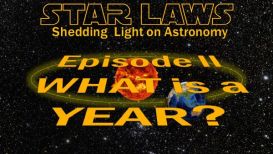 What is a year?
What is a year?
How big is the Sun compared to the Earth?
How far away is the Earth from the Sun?
What is a leap year?
How fast does the Earth travel around the Sun?
Why are our years numbered the way that they are?
What do AD and BC mean?
What do CE and BCE mean?
These questions are all answered in this sun-sational video!
A Short Excerpt:
EXCERPT COMING SOON.
 The STAR LAWS Episode I Question Sheet for Students:
The STAR LAWS Episode I Question Sheet for Students:
![]() The PDF version.
The PDF version. ![]()
Google The Google Doc version. Google
![]() The Microsoft Word version.
The Microsoft Word version.![]()
![]() If you have ClickView, watch the whole episode here.
If you have ClickView, watch the whole episode here.
![]() If you have Learn360, watch the whole episode here.
If you have Learn360, watch the whole episode here.
Transcript: PICTURES COMING SOON
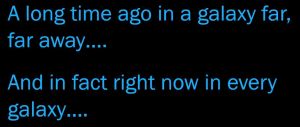


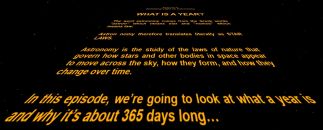
The word astronomy comes from the Greek words astron which means star and the word nomos which means “law”. Astron nomy therefore translates literally as STAR LAWS. Astronomy is the study of the laws of nature that govern how stars and other bodies in space appear to move across the sky, how they form, and how they change over time.
In this episode, we’re going to look at what a year is and why it’s about 365 days long…
 Hi Everyone. It’s Spiro here. Welcome to the second episode of the STAR LAWS series, aka the Shedding Light on Astronomy series.
Hi Everyone. It’s Spiro here. Welcome to the second episode of the STAR LAWS series, aka the Shedding Light on Astronomy series.
We’re all pretty familiar with the concept of the year. When people ask us our age we usually answer in years. We typically know what year we were born in. But what exactly is a year? Let’s take a look!
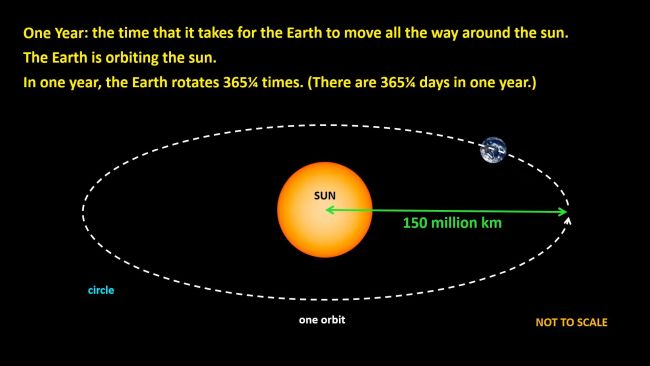 The Earth is moving around the Sun in more or less a circle at a distance of about 150 million kilometres. One year is the time that it takes for the Earth to move all the way around the Sun once and to get back to where it started from. In technical language, we say that the Earth is orbiting the Sun and that a year is the time that it takes to complete one orbit. If, for example, you’re 15 years old, you’ve been all the way around the Sun 15 times.
The Earth is moving around the Sun in more or less a circle at a distance of about 150 million kilometres. One year is the time that it takes for the Earth to move all the way around the Sun once and to get back to where it started from. In technical language, we say that the Earth is orbiting the Sun and that a year is the time that it takes to complete one orbit. If, for example, you’re 15 years old, you’ve been all the way around the Sun 15 times.
In one orbit (that is, in one year), the Earth rotates 365¼ times which means that there are 365¼ days in a year.
Now this animation is nowhere near to scale.
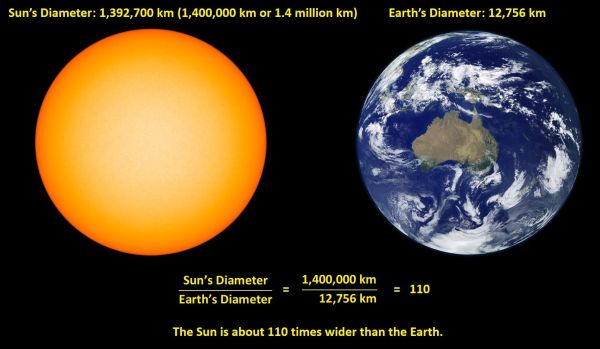
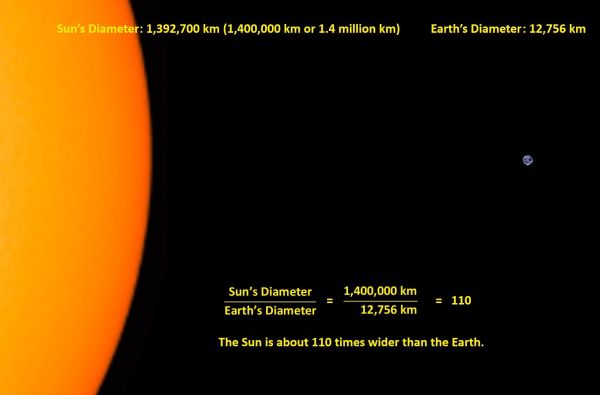
The Earth’s diameter is about 12,756 km and the Sun’s diameter is about 1,392,700 km (that is, just under 1,400,000 km or 1.4 million km). It’s this rounded-off figure that I’m going to use from now on. If we divide the Sun’s diameter by the Earth’s diameter (1.4 million kilometres by 12,756 km, we get 110. The Sun is about 110 times wider than the Earth. To draw it to scale, I have to shrink the Earth right down until it’s only this big, barely visible but to scale. If I zoom in a bit to make the Earth a little bigger, the Sun is so big that it doesn’t fit onto the screen.
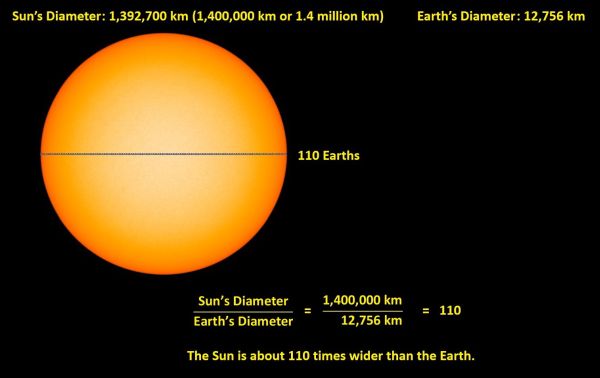 Another way of thinking of the size difference is that 110 Earths could fit end-to-end from one side of the Sun to the other. The Sun is really really big. It’s 110 Earths wide!
Another way of thinking of the size difference is that 110 Earths could fit end-to-end from one side of the Sun to the other. The Sun is really really big. It’s 110 Earths wide!
In terms of volume, about 1.3 million Earths could fit inside the Sun if the Sun was a hollow container.
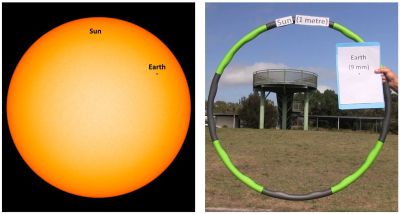 If the Sun had a diameter of 1 metre which is about the diameter of this hoop, then the Earth would have a diameter of only 1 110th of 1 metre, which is 0.9 of a cm, that is, 9 mm, which is the diameter of this small black dot on this paper.
If the Sun had a diameter of 1 metre which is about the diameter of this hoop, then the Earth would have a diameter of only 1 110th of 1 metre, which is 0.9 of a cm, that is, 9 mm, which is the diameter of this small black dot on this paper.
However, the image on the left and the simple scale model on the right are not showing the distance between the Sun and the Earth to scale.
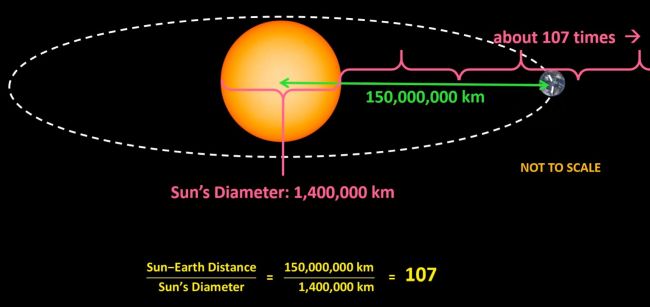 The actual distance between the Sun and the Earth is, as I said, about 150 million kilometres, (149,597,870 km) which is much bigger than the Sun’s diameter of 1,400,000 km, so again, nothing about this animation is to scale.
The actual distance between the Sun and the Earth is, as I said, about 150 million kilometres, (149,597,870 km) which is much bigger than the Sun’s diameter of 1,400,000 km, so again, nothing about this animation is to scale.
If we divide the Sun-Earth Distance by the Sun’s diameter, 150 million kilometres by 1 million 400 thousand kilometres, we get 107. Whatever, the diameter of the Sun is on the screen you’re watching, the Earth would need to be about 107 times this distance away. Another way of looking at it is that you can fit about 107 suns between the Earth and the Sun!

If I shrink down the Sun and extend the green line, then the size of the Sun and the Sun-Earth distance have been drawn to scale, but the barely visible little white dot I’ve put in here to represent the Earth has been drawn about 10 times too big and so is not to scale. It needs to be 1/10 of the size shown but it just wouldn’t be visible on the screen if I made it that small.
(On a HD screen, it’s literally not possible to draw a dot 1/10 the size of this dot. High Definition TV screens are made of tiny little pixels coloured red, green, and blue. To draw the Earth to scale, the dot would have to be about 1/5 the width of a single pixel, which can’t be done!)
Our Earth is just a tiny speck in a vast expanse of mostly empty space. As I said, there’s enough space between the Earth and the Sun to fit about 107 suns in between!
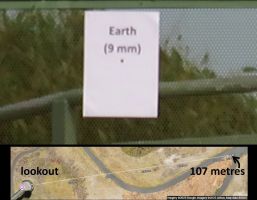
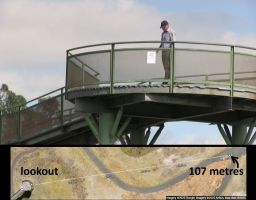
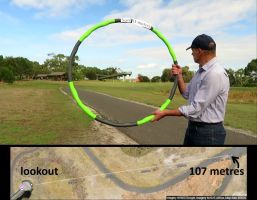
On a scale model where the diameter of the Sun is 1 metre and the diameter of the Earth is 9 mm, the earth would have to be about 107 metres away from the Sun.
Let me show you what that looks like. Here you can see me sticking the paper with the 9 mm Earth on it onto this lookout and I’m going to position the Sun 107 metres away. We had to zoom in 200 times to get this shot and though it’s a little blurry, the Earth dot is clearly visible. We then had to zoom out a long long long long long way and by the time the pretend Sun entered the shot, you can barely see the paper let alone the dot. The distance between the hoop Sun and the Earth dot is about 107 metres. The Earth is tiny compared to the Sun and even tinier compared to the distance between the Earth and the Sun.
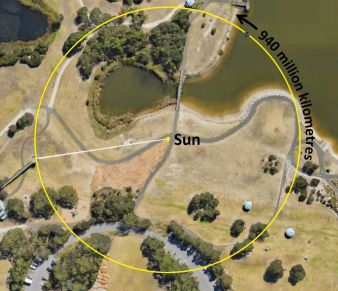
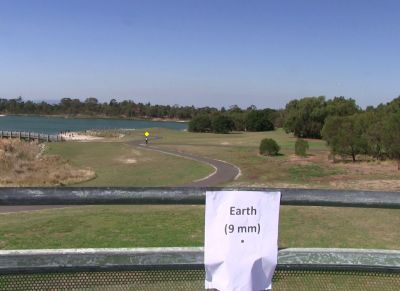
I can also film the situation from the other side. Here, the camera is positioned on the lookout platform and you can see that I’m holding the 1-metre-wide hoop that represents the Sun. If the camera zooms out until the Earth dot is visible as well, even the Sun looks tiny at this distance of 107 metres away from the Earth dot. You can see it better if I superimpose a flashing yellow dot onto the footage. The distances in astronomy are, well, astronomical.
The total distance that the Earth moves in its more-or-less circular orbit around the Sun is about 940 million kilometres in real life. As I said, astronomical!
So, the Earth takes a year to orbit the Sun. That’s what a year is: the time that the Earth takes to orbit the Sun. The orbit is not exactly a circle, but it’s pretty close. In that time of one year, the Earth rotates 365¼ times. In other words, there are 365¼ days in a year. But what do we do about that quarter day?
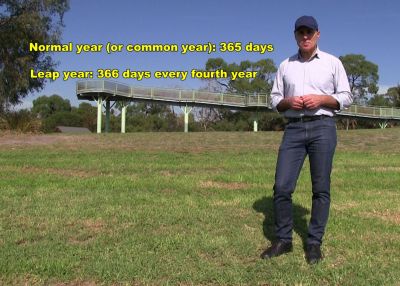 Well, we have leap years! For three years in a row we have what is called a normal year (or a common year) of 365 days, and then we have a leap year of 366 days every fourth year. This averages out to 365¼ days.
Well, we have leap years! For three years in a row we have what is called a normal year (or a common year) of 365 days, and then we have a leap year of 366 days every fourth year. This averages out to 365¼ days.
The extra day is always added at the end of February. February typically has 28 days, but in a leap year it has 29 days. Leap years occur every four years in the years that are divisible by 4: 2024, 2028, 2032, and so on.
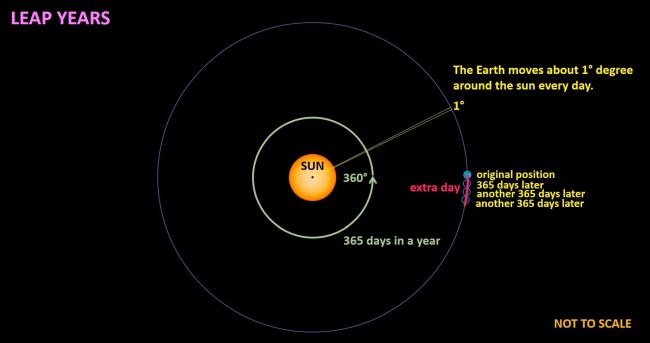 Let’s take a look at what happens (astronomically). In the first normal year, the Earth goes almost but not quite all the way around the Sun and ends up about here 365 days later, slightly short of where it started 365 days earlier. In the following normal year, it does the same thing and again falls slightly short after another 365 days. In the third normal year, it falls short again another 365 days later, but in the fourth year, the leap year that has 366 days, the extra day allows the Earth to move back to where it was 4 years earlier, and the cycle starts again. Nothing here is to scale by the way, but that’s basically how leap years work.
Let’s take a look at what happens (astronomically). In the first normal year, the Earth goes almost but not quite all the way around the Sun and ends up about here 365 days later, slightly short of where it started 365 days earlier. In the following normal year, it does the same thing and again falls slightly short after another 365 days. In the third normal year, it falls short again another 365 days later, but in the fourth year, the leap year that has 366 days, the extra day allows the Earth to move back to where it was 4 years earlier, and the cycle starts again. Nothing here is to scale by the way, but that’s basically how leap years work.
In reality, the Earth doesn’t move anywhere near this distance shown in pink in the animation in one day. Given that a circle is divided into 360° and that there are about 365 days in a year, the Earth moves about 1 degree around the Sun every day. The angle between the two yellow lines is one degree.

The angle between these two green lines is also 1°. The diameter of the Sun and the Sun-Earth distance (represented by the green lines) are to scale here, but the white dots that I’ve drawn in to represent the Earth are, again, about 10 times too big. Remember, the Earth is a tiny speck compared to the distance between the Earth and the Sun.
The actual distance that the Earth moves around the Sun in one day is about 2.6 million kilometres. This is just under the distance of two suns placed next to each other or a little over 200 times the width of the Earth which I can’t really show you in this animation. All I can say is that a little over two hundred Earths could fit along this flashing line. The Earth’s speed as it orbits the Sun is about 107,000 km/hr, which equates, as I said, to about 2.6 million kilometres per day.
Wherever you are right now, in a day’s time you’ll be 2.6 million kilometres away, but you won’t notice it because everything else around you will also have travelled 2.6 million kilometres.
We’re all on the same ride together!
It turns out that the earth moves at 107,000 km/hr, so in 24 hours (one day) it travels 2.6 million km. 2.6/1.4 = 1.857 Sun diameters. EVERY DAY.
So, a year is the time that it takes for the Earth to go all the way around the Sun, that is, to make one complete orbit. But why are years numbered the way that they are? As I record this video, it’s 2025. What does that mean?
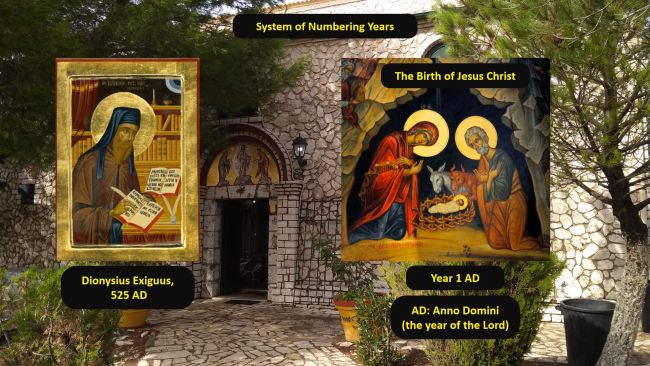
Our system of numbering years was developed by a Christian monk called Dionysius Exiguus in the year 525 AD in Rome. Up until then, years were numbered in a number of different ways, but one way was to say, for example, “in the 8th year of the reign of Emperor Flavius Iustinus Augustus” or something like that. Records were kept of how long each Emperor ruled. Dionysius, being a Christian, decided to use as much information in the historical records that he could find to work out the year that Jesus Christ was born and he designated that year as Year 1 AD. AD stands for Anno Domini which translates as “the year of the Lord”. In Latin, anno relates to the word “year”. Our English word annual, which means yearly, comes from the Latin word anno. The word Domini is the Latin word for “Lord”, which refers to Jesus. A few hundred years later, the English monk and historian known as Bede the Venerable extended the system by adding BC to represent the years before Christ’s birth. BC stands for Before Christ. The AD/BC system became widely used in Europe and eventually spread globally.
So, under this system, this year, the year that I’m making this video, is 2025 AD, which means it’s been about 2025 years since Jesus was born.
Many people now refer to the years as either being CE and BCE, so 2025 AD is also called 2025 CE. CE stands for common era and BCE stands for before common era. The word “common” in Common Era refers to the shared calendar system that is commonly used around the world. The system avoids any obvious religious meaning, but it’s still ultimately based on the year of birth of Jesus Christ. Many countries use words in their language that translate simply as Before Christ and After Christ.
And so that’s it for this lesson.
We’ve seen some big numbers, but in summary, the Earth takes 1 year to orbit the Sun. In that time, it rotates 365¼ times. The Sun is about 110 times wider than the Earth, and its distance from the Earth of about 150 million kilometres is about 107 times its diameter.
Thanks for watching. See you next time.
CREDITS:
Image of Coin: Solidus of Justin I (obverse).jpg by Coins Archive. https://en.wikipedia.org/wiki/File:Solidus_of_Justin_I_(obverse).jpg. Creative Commons License.
Google Maps https://www.google.com/maps/
Star Wars Style March by Humanoide_Media
https://pixabay.com/music/main-title-star-wars-style-march-165111/
Invasion March – Star Wars Style Cinematic Music by Humanoide_Media
https://pixabay.com/music/main-title-invasion-march-star-wars-style-cinematic-music-219585/
Star-Wars-style opening crawl generated at the STAR WARS Intro Generator website: https://starwarsintrogenerator.com/



